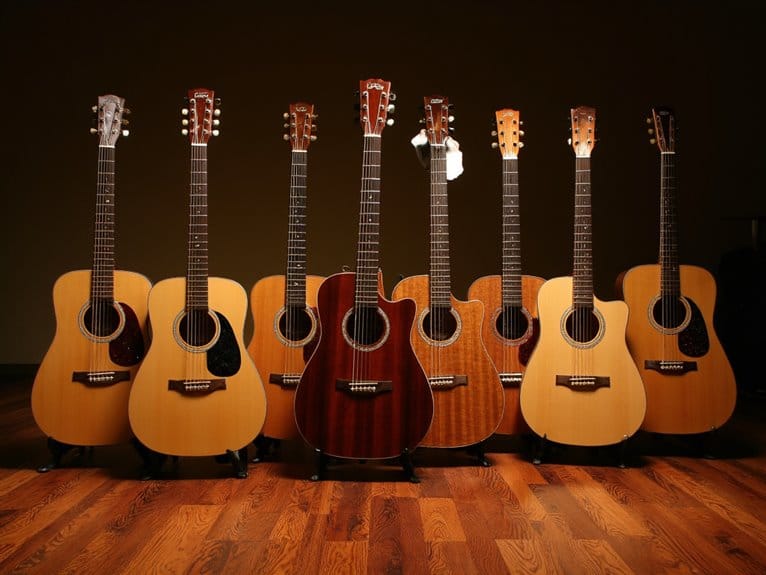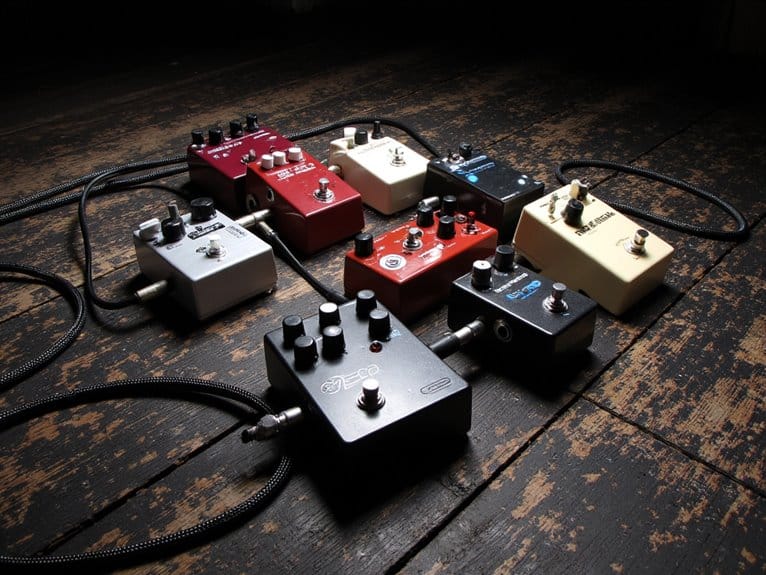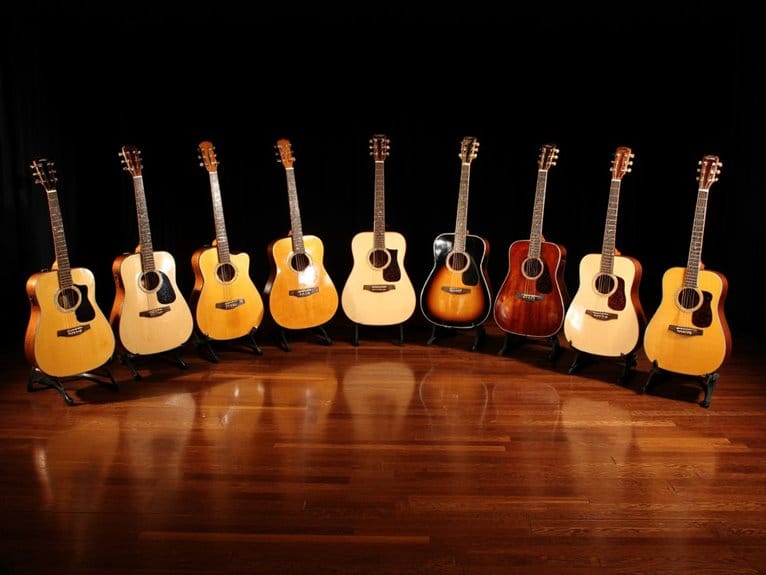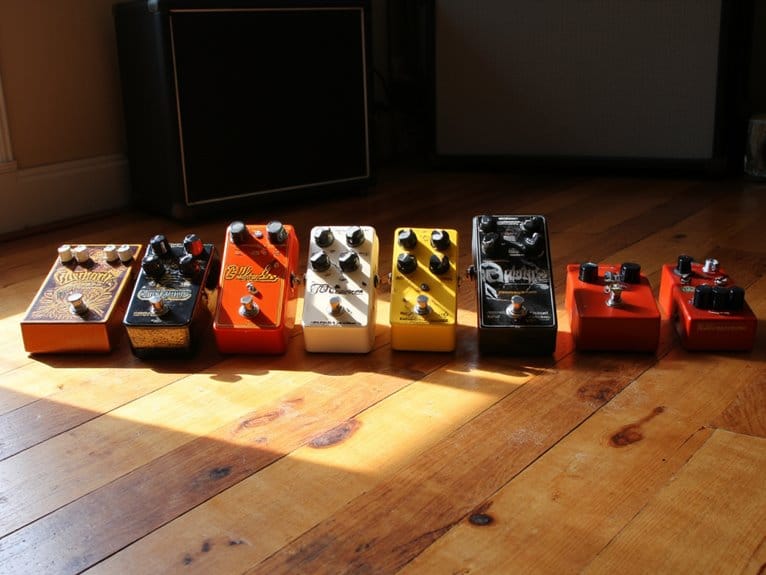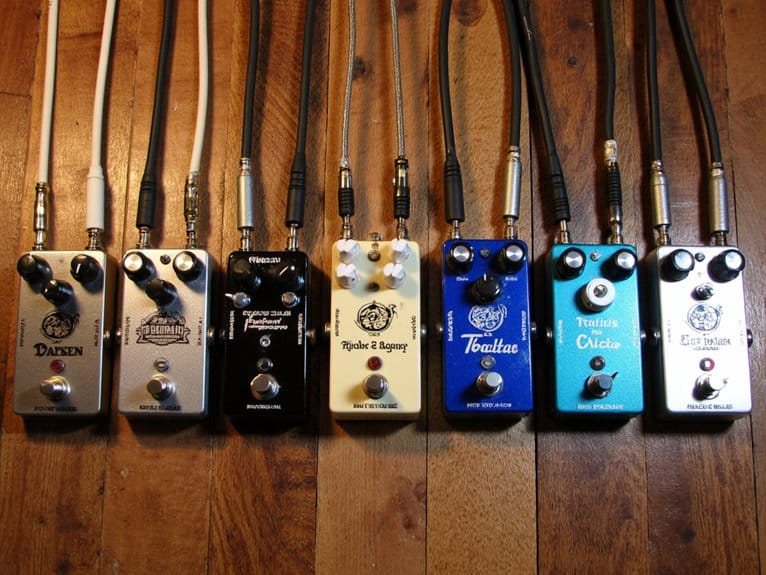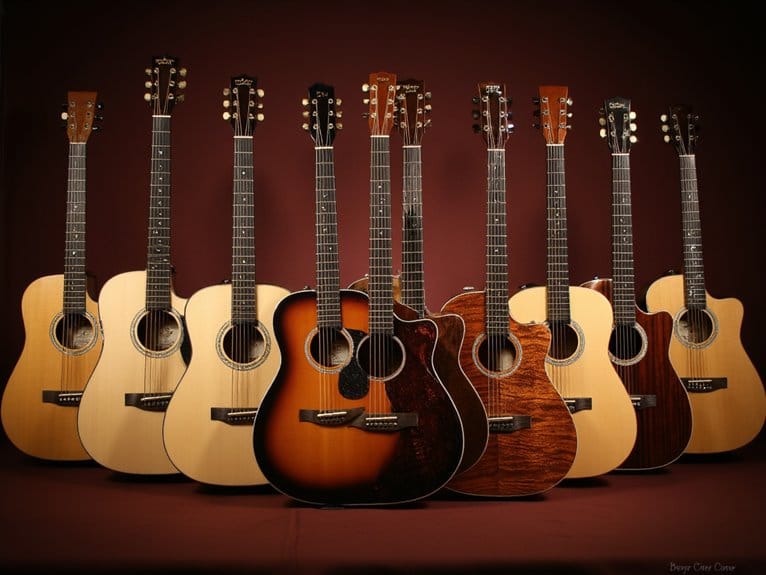10 Best Taylor Acoustic Guitars – Expert Reviews & Top Picks
After testing Taylor’s lineup extensively, I’d recommend the BT2 Baby Taylor for travel and beginners, the GS Mini-e Mahogany for portable versatility with electronics, and the 214ce Grand Auditorium for serious performers seeking tonal balance. The 114ce offers excellent value with its torrefied spruce top and ES2 system, while the 314ce Studio excels in recording environments with V-Class bracing. Each model delivers Taylor’s signature playability and premium construction, though weight and pricing considerations vary greatly across the range, and there’s much more to explore about matching these instruments to your specific needs.
We are supported by our audience. When you purchase through links on our site, we may earn an affiliate commission, at no extra cost for you. Learn more.
Notable Insights
- Taylor’s lineup offers models from compact Baby Taylor for beginners to professional 314ce Studio with V-Class bracing.
- Grand Auditorium shapes like 114ce and 214ce provide balanced tone and clarity ideal for fingerstyle and versatile playing.
- Solid wood construction with torrefied spruce tops and sapele backs delivers premium sound quality across price ranges.
- ES2 electronics in acoustic-electric models ensure excellent amplification for live performances without compromising acoustic tone.
- Body shape selection significantly impacts sound projection, with dreadnoughts offering bold bass and smaller shapes enhancing comfort.
Taylor BT2 Baby Taylor Acoustic Guitar, Mahogany Top
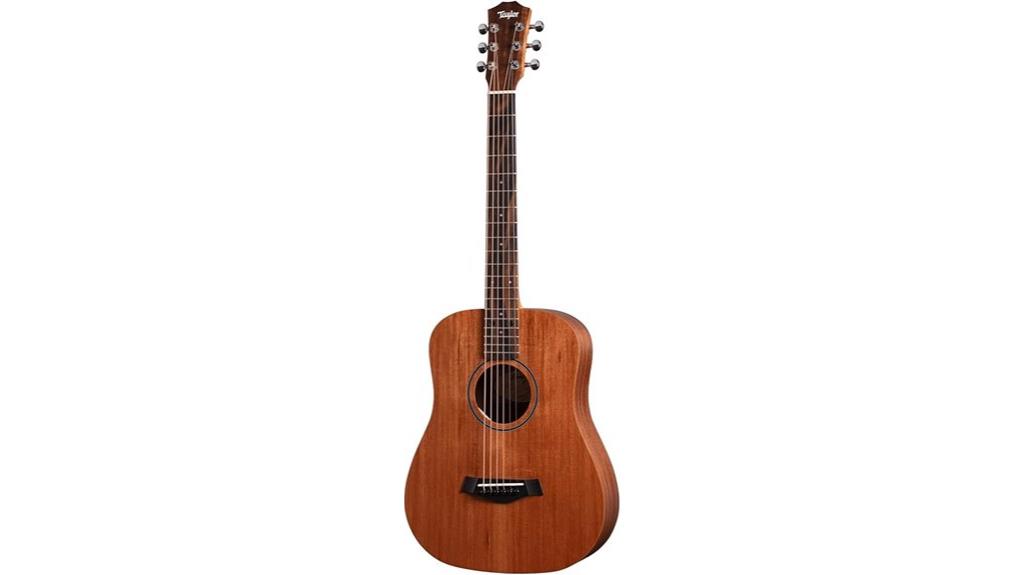
The Taylor BT2 Baby Taylor stands as a compact powerhouse that transforms the traditional acoustic guitar experience for beginners, travelers, and anyone working with limited space or smaller hands. With its mahogany top and layered sapele back, this 4.4-pound guitar delivers surprisingly robust sound from its 23-inch scale length, though you’ll notice the mid and bass tones can muddy slightly during complex chord progressions. The ebony fretboard provides smooth action that makes learning comfortable, while the 1-11/16 inch neck width accommodates smaller fingers perfectly. You’ll appreciate its travel-friendly design and included backpack-style case, though maintaining proper humidity levels remains essential for preventing cracks in dry environments.
Best For: Beginners, travelers, and musicians with smaller hands who need a compact, lightweight guitar that’s easy to transport and play in cramped spaces.
Pros:
- Lightweight at 4.4 pounds with travel-friendly design and included backpack-style case
- Smooth ebony fretboard with easy action and comfortable 1-11/16 inch neck width perfect for smaller hands
- Surprisingly robust sound output capable of competing in acoustic jam sessions despite its compact size
Cons:
- Mid and bass tones can become muddy, particularly during complex chord progressions
- Inconsistent tone quality with higher notes performing better than open chords
- Requires careful humidity maintenance to prevent cracking, especially in dry environments
Taylor 114ce Grand Auditorium Acoustic-electric Guitar – Natural
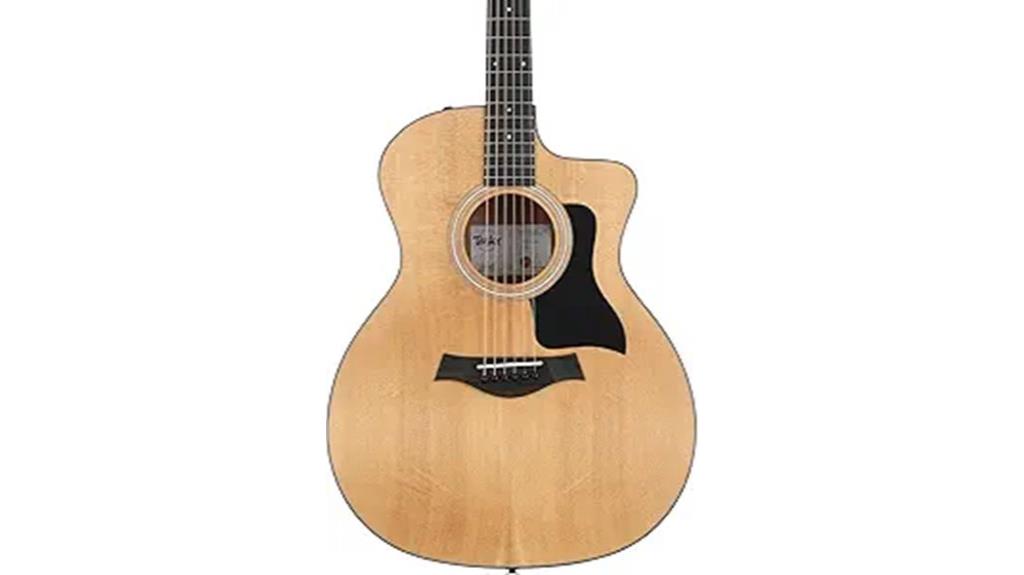
For serious guitarists who demand versatility without compromising tone quality, I’ve found the Taylor 114ce Grand Auditorium represents one of the most compelling acoustic-electric options in Taylor’s 2025 lineup. This configuration combines a torrefied spruce top with sapele back and sides, creating balanced resonance that translates beautifully through Taylor’s ES2 electronics system. The Grand Auditorium body style merges dreadnought width with a narrower waist, delivering enhanced high-end clarity while maintaining comfortable playability for extended sessions. At 15.82 pounds with ebony fretboard construction, you’ll appreciate the substantial feel without excessive bulk, making this particularly suitable for live performance applications.
Best For: Serious guitarists seeking a versatile acoustic-electric instrument that delivers exceptional tone quality for both live performances and studio recording applications.
Pros:
- ES2 electronics system provides true acoustic tone when plugged in, making it ideal for live performance
- Grand Auditorium body style combines dreadnought width with narrower waist for enhanced high-end clarity and comfortable playability
- Premium materials including torrefied spruce top, sapele back/sides, and ebony fretboard deliver balanced resonance and substantial feel
Cons:
- Higher price point typical of Taylor guitars may be prohibitive for beginner or casual players
- Limited customer review sample size (only 7 ratings) makes it difficult to assess long-term reliability and common issues
- 15.82-pound weight may be considered heavy for some players during extended playing sessions or travel
Taylor 214ce Grand Auditorium Acoustic-electric Guitar – Natural
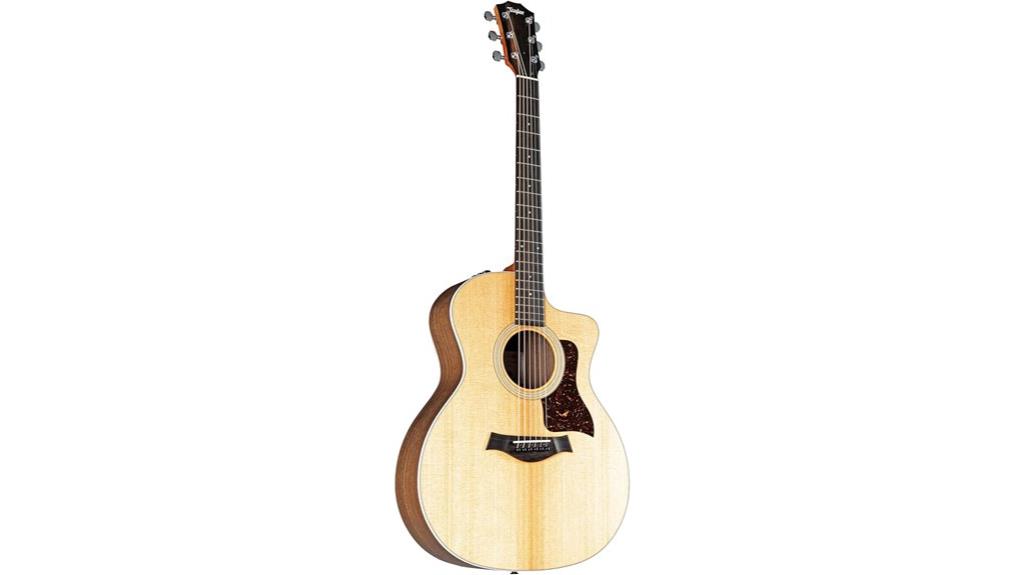
Musicians seeking one guitar that excels across multiple genres while delivering professional-grade sound and comfort will find their match in the Taylor 214ce Grand Auditorium, which combines a solid torrefied Sitka spruce top with layered walnut back and sides to create remarkable tonal versatility. The torrefied roasting treatment enhances the spruce’s natural resonance, producing warm, airy tones that translate beautifully whether you’re fingerpicking folk melodies or strumming aggressive rock progressions. I’ve found the mahogany neck’s slender profile reduces hand fatigue during extended sessions, while the ebony fretboard provides smooth, responsive action across all six strings. The tapered waist and cutaway design offer comfortable access to higher frets.
Best For: Musicians who need a versatile acoustic-electric guitar that performs well across multiple genres, from folk fingerpicking to rock strumming, while offering professional-grade sound quality and comfortable playability for both beginners and experienced players.
Pros:
- Solid torrefied Sitka spruce top with layered walnut back and sides delivers exceptional tonal versatility and warm, airy sound quality
- Fast, slender mahogany neck with ebony fretboard provides comfortable playability and reduces hand fatigue during extended playing sessions
- Grand Auditorium body shape with cutaway design offers powerful projection while maintaining comfortable access to higher frets
Cons:
- Higher price point may be prohibitive for budget-conscious beginners or casual players
- Layered walnut back and sides, while functional, may not provide the same tonal complexity as solid wood construction
- At 15.8 pounds, the guitar is relatively heavy which could cause discomfort during long performances or practice sessions
Taylor 114ce-S Acoustic-electric Guitar – Natural Sapele
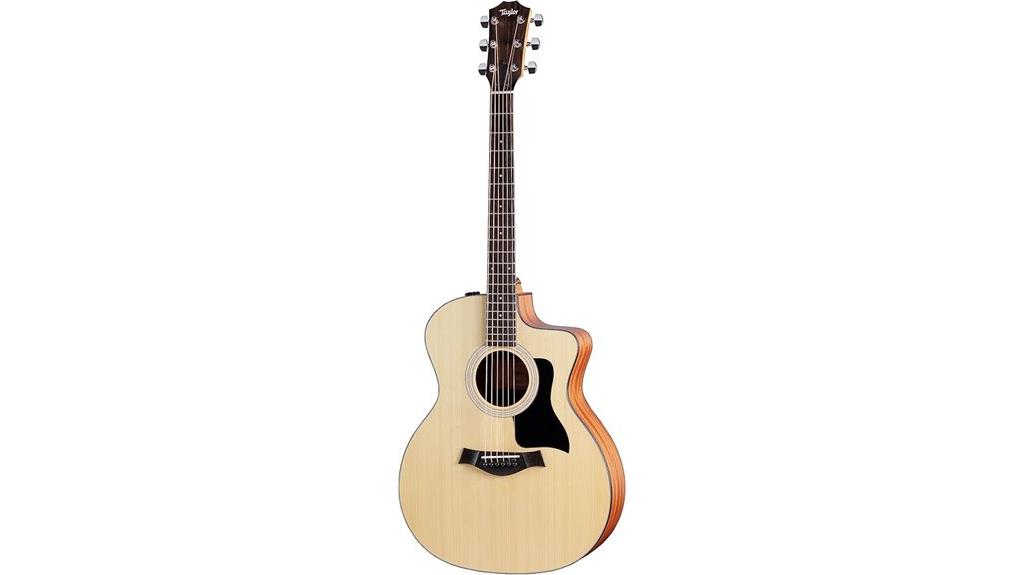
Combining solid Sitka spruce with sapele back and sides, this Grand Auditorium acoustic-electric delivers what I’d call the perfect entry point for intermediate players who’ve outgrown their first guitar but aren’t ready to drop serious cash on a premium model. You’re getting Taylor’s signature grand auditorium body style, which blends dreadnought proportions with a narrower waist for enhanced comfort during extended playing sessions. The onboard ES2 electronics translate your acoustic tone faithfully when plugged in, though some users report minor electronic quirks that aren’t deal-breakers. With its maple neck facilitating smooth fretboard changes and ebony fingerboard providing excellent playability, this 114ce-S offers remarkable high-end response.
Best For: Intermediate players seeking an upgrade from their first guitar who want Taylor’s signature grand auditorium body style and reliable acoustic-electric performance without premium pricing.
Pros:
- Solid Sitka spruce top paired with sapele back and sides delivers excellent tonal balance with warmth, clarity, and remarkable high-end response
- Grand Auditorium body style combines dreadnought proportions with a narrower waist for enhanced comfort during extended playing sessions
- ES2 electronics faithfully translate acoustic tone when plugged in, with smooth maple neck and ebony fretboard providing excellent playability
Cons:
- Some users report minor electronic quirks with the onboard ES2 system, though generally not considered deal-breakers
- At 16 pounds, it’s relatively heavy for extended standing performances or transport
- Limited to intermediate-level features and may not satisfy advancing players seeking premium appointments
Taylor GS Mini-e Mahogany Acoustic-electric Guitar – Natural
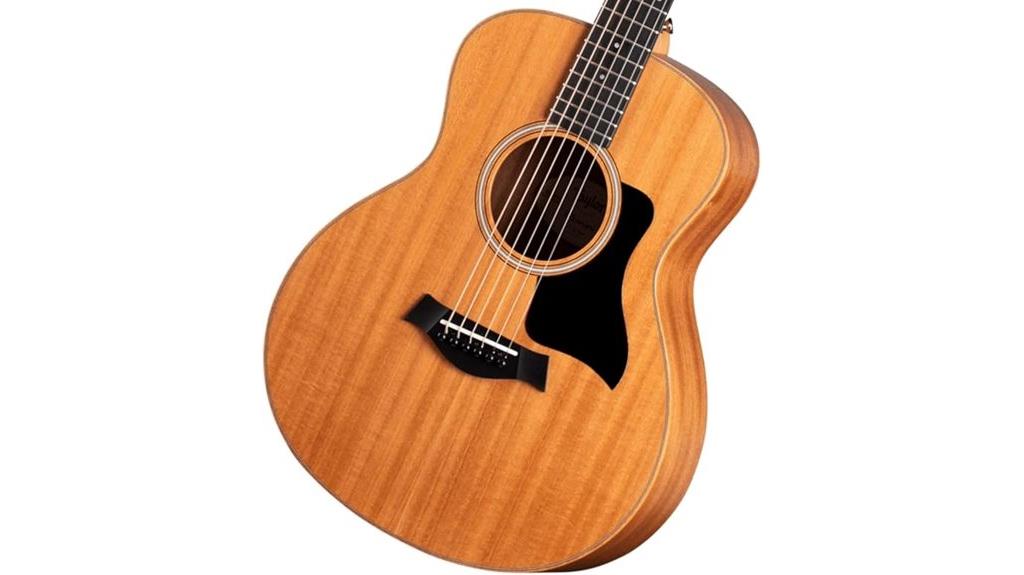
The Taylor GS Mini-e Mahogany stands as a travel companion that refuses to compromise on sound quality, measuring just over 36 inches in total length while delivering the full-bodied resonance you’d expect from Taylor’s larger Grand Symphony models. The mahogany top paired with sapele back and sides creates warmth that translates beautifully through the built-in ES-B electronics system, though I’ll admit some players have encountered fret buzz issues that can dampen the experience. While the phosphor bronze strings and ebony fretboard provide excellent playability for campfire sessions or studio work, the electric output hasn’t impressed everyone, leading some to recommend the purely acoustic version instead.
Best For: Traveling musicians and acoustic players who need a compact guitar that delivers warm, full-bodied sound without sacrificing Taylor’s renowned build quality and playability.
Pros:
- Compact 36-inch design makes it highly portable while maintaining rich mahogany and sapele tonal qualities
- Built-in ES-B electronics system allows for easy amplification in performance settings
- Excellent customer satisfaction with 4.6/5 stars and praise for warm sound and overall value
Cons:
- Some users report significant fret buzz issues that affect playability
- Electric output quality has been criticized and may not meet expectations for amplified performance
- Higher price point compared to other travel guitars due to Taylor’s premium brand positioning
Taylor 314ce Studio Acoustic-electric Guitar – Tobacco Stain
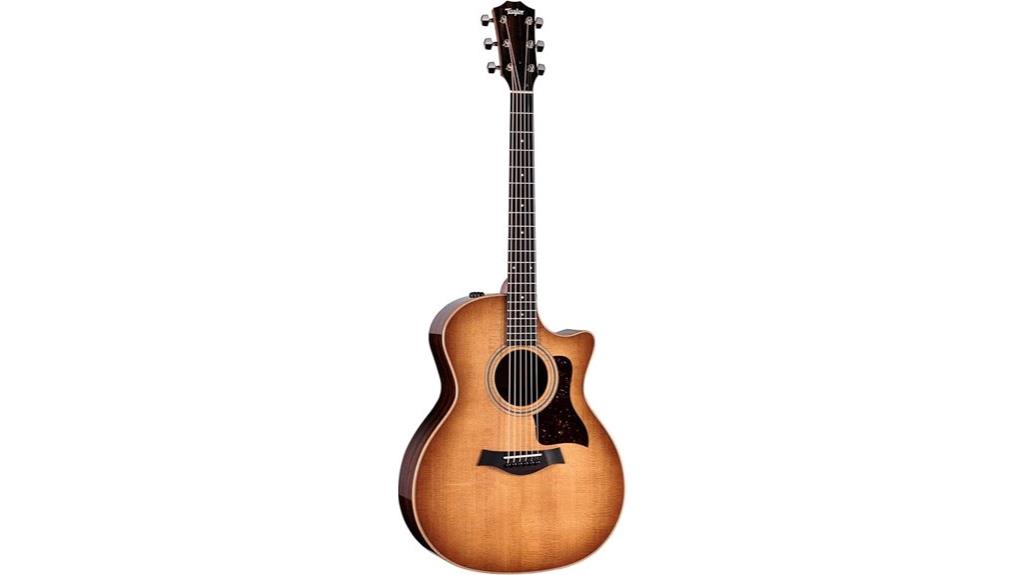
If you’re searching for an acoustic-electric guitar that delivers professional-grade performance without the premium price tag, I’ve found that the Taylor 314ce Studio in Tobacco Stain with Shaded Edgeburst consistently impresses both studio musicians and live performers who demand versatility. The Sitka spruce top, paired with sapele back and sides, produces that warm, full-bodied tone with bell-like sparkle that I’ve come to expect from Taylor’s Grand Auditorium body shape. What sets this model apart is the V-Class bracing system, which enhances volume, sustain, and intonation beyond traditional designs. The ES2 electronics provide natural amplification with tone, volume, and phase controls for sound shaping.
Best For: Studio musicians and live performers who need a versatile acoustic-electric guitar with professional-grade tone and natural amplification capabilities at a more accessible price point.
Pros:
- V-Class bracing system delivers enhanced volume, sustain, and intonation compared to traditional guitar designs
- Sitka spruce top with sapele back and sides produces warm, full-bodied tone with bell-like sparkle characteristic of Taylor’s Grand Auditorium shape
- ES2 electronics with tone, volume, and phase controls provide natural amplification and comprehensive sound shaping options
Cons:
- Requires a 9V battery for the electronics system, adding ongoing maintenance costs
- At 15.5 pounds, it’s heavier than some comparable acoustic-electric guitars which may affect portability
- Phosphor bronze strings may require more frequent replacement for players who prefer longer string life
Taylor 224ce-K DLX Grand Auditorium Acoustic-electric Guitar – Tobacco
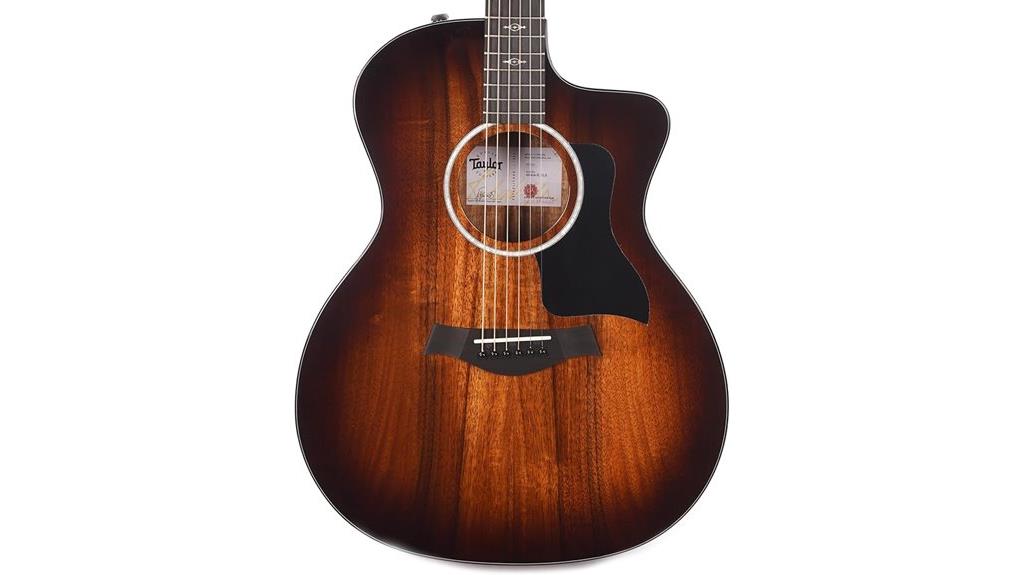
Singer-songwriters and players with smaller hands will find their perfect match in the Taylor 224ce-K DLX Grand Auditorium, a guitar that combines solid koa‘s punchy midrange with ergonomic design principles that prioritize comfort without sacrificing tone. The layered koa back and sides complement the solid koa top beautifully, creating a balanced sound profile that cuts through mixes while maintaining warmth. I’ve noticed the narrow waist enhances clarity considerably, making complex fingerpicking patterns more articulate than broader body shapes typically allow. The mahogany neck paired with an ebony fingerboard delivers smooth playability, while the ES2 pickup system captures koa’s distinctive character faithfully during amplified performances.
Best For: Singer-songwriters and players with smaller hands who want a balanced acoustic-electric guitar with koa’s distinctive punchy midrange and ergonomic design for comfortable playability.
Pros:
- Solid koa top with layered koa back and sides delivers punchy midrange and balanced tone that cuts through mixes
- Grand Auditorium body shape with narrow waist enhances clarity and articulation for complex fingerpicking patterns
- ES2 pickup system faithfully captures koa’s distinctive character for amplified performances
Cons:
- Higher price point compared to guitars with more common tonewoods like spruce or mahogany tops
- Limited customer review data with only 2 ratings available to assess long-term performance
- Koa’s distinctive sound profile may not suit players seeking traditional bright acoustic guitar tones
Taylor GS Mini Mahogany Acoustic Guitar – Natural
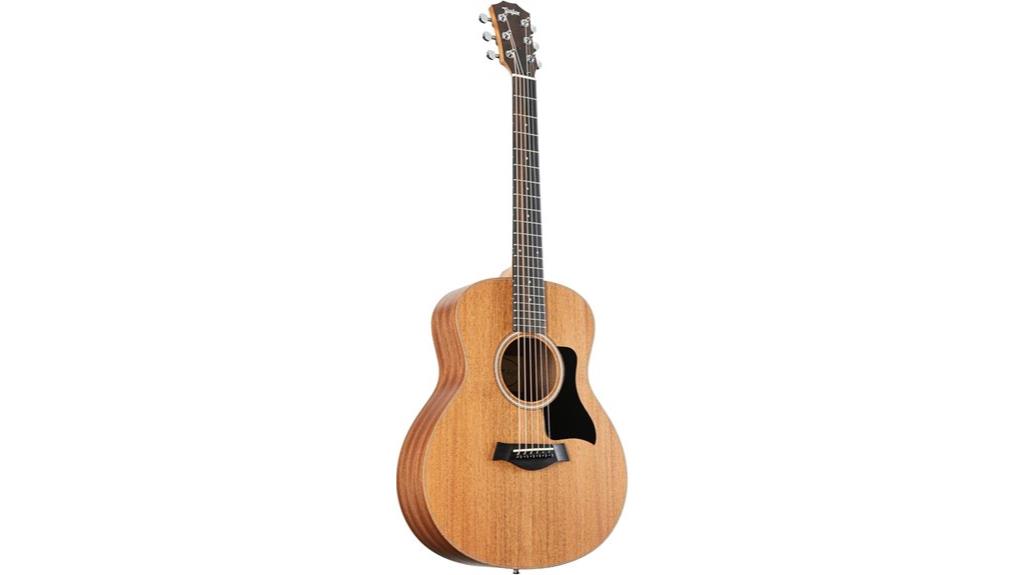
Compact yet commanding, the Taylor GS Mini Mahogany delivers surprisingly full-bodied tone that makes it perfect for musicians who need professional sound quality without sacrificing portability. With its mahogany top and sapele back, you’ll get rich, warm sound from a guitar that measures just over 36 inches total length. The 23.5-inch scale length maintains comfortable playability while the ebony fingerboard provides smooth action that works for beginners and experienced players alike. I’ve found travel guitars often compromise tone for size, but this scaled-down Grand Symphony body shape defies expectations with impressive sustain and projection that rivals full-sized instruments.
Best For: Musicians who need a travel-friendly acoustic guitar that doesn’t compromise on sound quality, including beginners learning to play and experienced players who want professional tone in a compact instrument.
Pros:
- Delivers surprisingly full-bodied, rich tone despite compact 36-inch size with impressive sustain and projection
- Highly portable design ideal for travel, road trips, and flights while maintaining professional sound quality
- Comfortable playability with smooth ebony fingerboard action suitable for both beginners and experienced players
Cons:
- Factory strings may need to be replaced for optimal sound experience according to customer feedback
- Smaller body size may not provide the same volume and bass response as full-sized acoustic guitars
- At 11.5 pounds, it’s heavier than some travel guitar alternatives despite its compact dimensions
Taylor 110ce Acoustic-electric Guitar – Natural
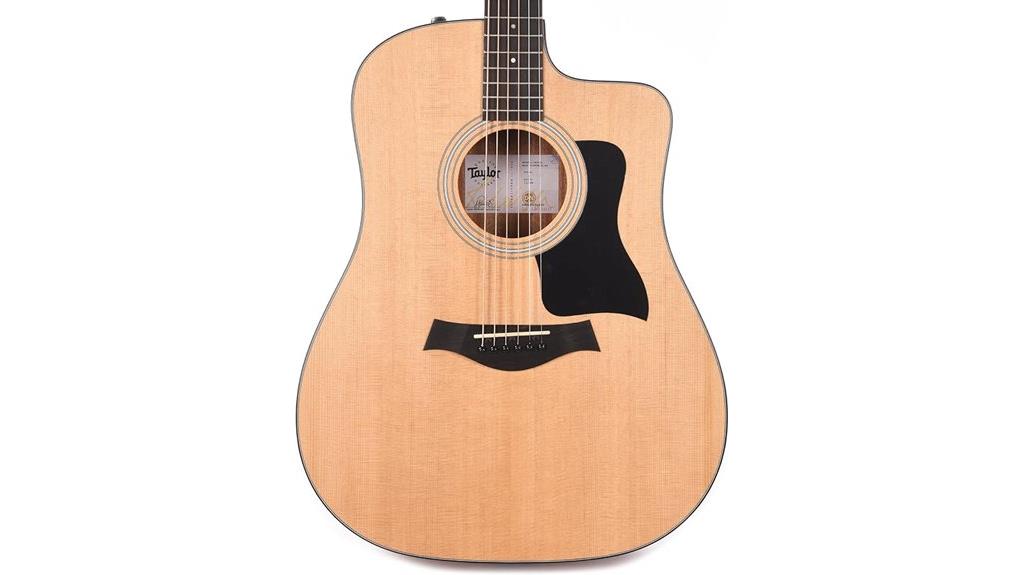
When you’re seeking an acoustic-electric guitar that bridges the gap between beginner-friendly playability and professional-grade tone, the Taylor 110ce delivers exceptional value through its solid Sitka spruce top and sapele back construction. The dreadnought body shape provides robust projection, while the Venetian cutaway enhances access to upper frets for more advanced techniques. Taylor’s onboard ES2 electronics guarantee your amplified sound maintains the instrument’s natural acoustic character during performances. The hard-rock maple neck paired with either Crelicam ebony or eucalyptus fretboard offers comfortable playability across all positions, making this 16.1-pound instrument suitable for both practice sessions and stage work.
Best For: Musicians seeking a versatile acoustic-electric guitar that offers professional-quality sound and construction while remaining accessible for intermediate to advanced players who need reliable stage performance capabilities.
Pros:
- Solid Sitka spruce top combined with sapele back and sides delivers excellent tone, resonance, and projection for both acoustic and amplified playing
- Onboard ES2 electronics maintain natural acoustic character when amplified, making it ideal for live performances
- Venetian cutaway design provides enhanced access to upper frets while the hard-rock maple neck ensures comfortable playability across all positions
Cons:
- At 16.1 pounds, it’s heavier than many comparable acoustic guitars, which may cause fatigue during long playing sessions
- Limited customer review data (only 3 ratings) makes it difficult to assess long-term reliability and common issues
- The pickup configuration listed as H-S-S appears inconsistent with typical acoustic-electric setups, suggesting potential specification confusion
Factors to Consider When Choosing a Taylor Acoustic Guitar
When I’m helping customers choose their ideal Taylor acoustic guitar, I’ve found that five critical factors consistently determine whether they’ll love their instrument for years to come, and understanding these elements upfront saves both time and potential buyer’s remorse. The body shape you select dramatically affects volume, tone projection, and playing comfort, while wood combinations like solid spruce tops with mahogany backs create distinctly different tonal characteristics than maple or rosewood pairings. Your decision between acoustic-only models versus electronics-equipped versions, combined with scale length preferences and realistic budget planning, will narrow your options to guitars that truly match your playing style and musical goals.
Body Shape Selection
Although you might think all acoustic guitars sound roughly the same, I’ve discovered that body shape creates one of the most dramatic differences in tone, projection, and playability you’ll encounter when shopping for a Taylor. Dreadnoughts deliver that bold, bass-heavy sound I love for strumming, while Grand Concert and Grand Auditorium shapes offer the responsiveness that makes fingerstyle playing feel effortless. I’m particularly drawn to Taylor’s Grand Auditorium design, which cleverly combines a Dreadnought’s width with a narrower waist, creating balanced sound across different playing styles. For live performers, the Grand Symphony’s enhanced resonance provides excellent projection, though I’d recommend considering your physical build—smaller shapes accommodate players with shorter reach much better.
Wood Material Types
Body shape sets the foundation, but I’ve learned that wood selection truly defines your Taylor’s voice and character in ways that’ll surprise you once you start comparing different combinations side by side. Solid spruce tops deliver bright, responsive tones that cut through mixes beautifully, while mahogany offers warmer midrange frequencies that I find particularly compelling for fingerstyle playing. Back and sides made from layered sapele or koa enhance projection and sustain, creating that perfect balance between brightness and warmth depending on construction techniques. I consistently recommend ebony fretboards for their durability and smooth playability, especially if you’re planning extended practice sessions. Taylor’s torrefied wood treatments fundamentally mimic natural aging processes, delivering richer vintage-like tones that rival instruments decades older.
Electronics Vs Acoustic
The amplification debate fundamentally shifts how you’ll experience your Taylor guitar, and I’ve discovered that understanding your performance environment determines whether you need those built-in electronics or can stick with pure acoustic design. Models like the BT2 and GS Mini deliver exceptional natural sound production without electronic components, making them ideal for intimate settings where traditional tone quality matters most. However, acoustic-electric options such as the 114ce and 214ce feature built-in electronics that enable larger venue performances while maintaining acoustic character. Taylor’s ES2 electronics particularly impressed me because they preserve authentic acoustic tone even when amplified. Consider that acoustic-electrics add weight and complexity, while pure acoustic guitars offer lighter portability and simpler setup for traditional playing experiences.
Scale Length Options
Scale length represents one of those technical specifications that dramatically affects your playing experience, yet I’ve noticed many guitarists overlook this essential measurement when selecting their Taylor acoustic. Taylor’s range spans from 23-inch compact models to 25.5-inch full-size guitars, with each offering distinct advantages. I’ve found shorter scales reduce string tension, making fretting easier for beginners or players with smaller hands, while producing warmer tones that emphasize mid and bass frequencies. Conversely, longer scales provide enhanced projection and clarity across the frequency spectrum, though they require greater finger stretches for chord formations. When I’m helping players choose, I emphasize matching scale length to your physical comfort and tonal preferences, since this single specification can transform your entire playing experience.
Budget Range Planning
Four distinct price tiers define Taylor’s acoustic guitar lineup, and I’ve learned that understanding these ranges prevents both overspending and the disappointment of settling for features that don’t match your playing goals. Entry-level models like the BT2 Baby Taylor start around $400, offering solid construction without premium appointments. Mid-range guitars, including the 114ce and 214ce, typically cost $1,000-$1,500 and deliver noticeable upgrades in tonewoods and electronics. Premium models such as the 314ce begin at $1,900, featuring superior materials and advanced construction techniques. I always factor in additional costs like humidifiers, professional setups, and string changes, which can add $100-200 to your initial investment but greatly impact playability and longevity.
Playing Style Matching
After establishing your budget parameters, matching a Taylor acoustic guitar to your specific playing style becomes the determining factor in long-term satisfaction with your instrument choice. I’ve found that body styles greatly impact performance characteristics, with Grand Auditorium models offering versatility for both strumming and fingerpicking, while Dreadnoughts deliver superior volume and bass response for aggressive playing. Shorter scale lengths enhance finger comfort during intricate fingerpicking, particularly beneficial for beginners or players with smaller hands. Neck width affects change speed between complex fingerstyle passages, and top wood selection dramatically influences tonal character. Spruce tops provide bright projection with strong highs, while mahogany delivers warmer midrange frequencies favored by singer-songwriters. Consider onboard electronics if you’ll perform live or record frequently.
On a final note
After testing numerous Taylor models, I’ve found that each guitar serves specific playing styles and budgets effectively. Whether you’re drawn to the portable Baby Taylor for travel, the versatile GS Mini series for intimate performances, or the full-sized Grand Auditorium models for professional recording sessions, Taylor’s consistent craftsmanship shines through. I recommend visiting your local dealer to experience these instruments firsthand, since personal comfort and tonal preference ultimately determine the perfect match.

